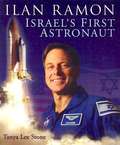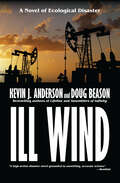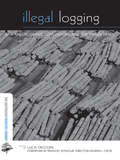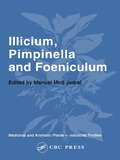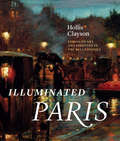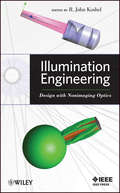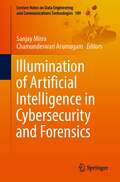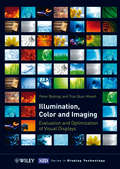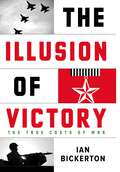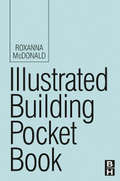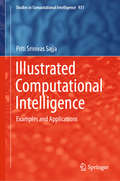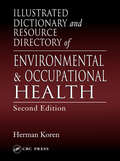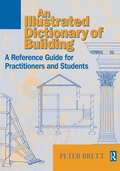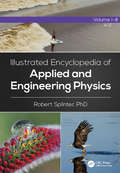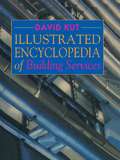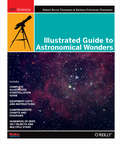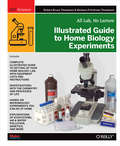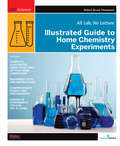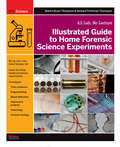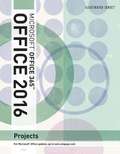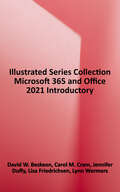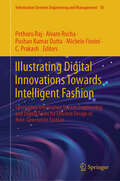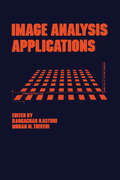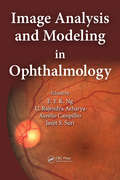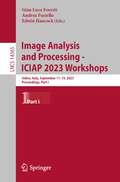- Table View
- List View
Ilan Ramon: Israel's First Astronaut
by Tanya Lee StoneStone tells of the first Israeli, Ilan Ramon, to travel to space.
Ill Wind: A Novel of Ecological Disaster
by Kevin J. Anderson Doug BeasonAn environmental disaster leads to global chaos in this science fiction thriller by the authors of Assemblers of Infinity. It is the largest oil spill in history: a supertanker crashes into the Golden Gate Bridge in San Francisco Bay. Desperate to avert environmental damage (as well as a PR disaster), the multinational oil company releases an untested designer oil-eating microbe to break up the spill. What the company didn&’t realize is that their microbe propagates through the air…and it mutates to consumer anything made of polycarbons: oil, gasoline, synthetic fabrics, plastics of all kinds. And when every piece of plastic begins to dissolve, it&’s too late . . . Praise for Ill Wind &“A high-action, best-seller-caliber disaster novel grounded in unsettlingly accurate science. . . . Using the standard disaster novel format of multiple characters and plot lines, Beason and Anderson maintain a suspenseful, breakneck pace that carries us to a thrilling finish.&” —Booklist&“A big, near-future disaster novel straddling the border between science fiction and technothriller, likely to appeal to fans of both.&” —Kirkus Reviews &“A real winner . . . [the authors&’] grasp of the science, the technology, and the political scene is unique.&” —Dr. D. Allan Bromley, former assistant to the president for science and technology
Illegal Logging: Law Enforcement, Livelihoods and the Timber Trade
by Luca Tacconi'This book carefully blends conceptual insights with extensive empirical evidence to navigate the reader through an issue that is still poorly understood [and is] a valuable reference for the development practitioner to understand the fundamental causes of illegal logging, its myriad consequences and the policy choices available to address the problem' Nalin Kishor, Forest Law Enforcement and Governance Coordinator, The World Bank 'An excellent resource for those working to conserve and sustainably manage forests worldwide. It offers an extensive and comprehensive study of illegal logging, bringing together the knowledge and views of experts who examine its roots and social, economic and environmental implications. One of its important contributions is to show that, unless coupled with reform of forestry regulations to take into account local people, law enforcement to curb illegal logging can negatively impact them. Therefore, any effective and fair approach to the problem needs to involve governments, forestry operators and local communities alike' Gonzalo Oviedo, Senior Social Policy Advisor, IUCN In many countries illegal logging now accounts for a large share of the harvest. Once cut, illegal logs feed an insatiable demand for exotic hardwoods in developed and developing countries. The result has been loss of both revenue and biodiversity, and consequently the issue has risen to the top of the global forest policy agenda as one of the major threats to forests, and donors and national governments are starting to develop initiatives to control illegal logging. Yet for such a massive illegal trade, there is surprisingly limited knowledge available as to the major causes of illegal logging and its impacts on biodiversity, people and livelihoods and national economies, and thus plenty of speculation and action without evidence. It is clear that while illegal logging does have negative impacts, it also, controversially, and perhaps paradoxically, benefits many stakeholders, including local communities. This book, written by the world's foremost experts, examines the key issues including law and enforcement, supply and demand, corruption, forest certification, poverty, local livelihoods, international trade and biodiversity conservation. It includes key case studies from forest-rich hotspots in North, South and Central America, equatorial Africa and Indonesia. While there are clearly no easy answers, this book sorts fact from fiction and explores the many dimensions of the causes, impacts and implications for forests, people, livelihoods and forest policy. Published with CIFOR
Illicium, Pimpinella and Foeniculum
by Manuel Miró JodralThe book includes current knowledge on Illicium verum (star anise) and Pimpinella anisum (aniseed), main commercial species rich in anetol. It also analyzes Foeniculum vulgare (fennel) and other species of Pimpinella (P. major, P. peregrina and P. saxifraga). This volume includes a botanical, chemical, pharmacological, and therapeutic survey of the
Illuminated Paris: Essays on Art and Lighting in the Belle Époque
by Hollis ClaysonThe City of Light. For many, these four words instantly conjure late nineteenth-century Paris and the garish colors of Toulouse-Lautrec’s iconic posters. More recently, the Eiffel Tower’s nightly show of sparkling electric lights has come to exemplify our fantasies of Parisian nightlife. Though we reflect longingly on such scenes, in Illuminated Paris, Hollis Clayson shows that there’s more to these clichés than meets the eye. In this richly illustrated book, she traces the dramatic evolution of lighting in Paris and how artists responded to the shifting visual and cultural scenes that resulted from these technologies. While older gas lighting produced a haze of orange, new electric lighting was hardly an improvement: the glare of experimental arc lights—themselves dangerous—left figures looking pale and ghoulish. As Clayson shows, artists’ representations of these new colors and shapes reveal turn-of-the-century concerns about modernization as electric lighting came to represent the harsh glare of rapidly accelerating social change. At the same time, in part thanks to American artists visiting the city, these works of art also produced our enduring romantic view of Parisian glamour and its Belle Époque.
Illumination Engineering
by R. John KoshelThis book brings together experts in the field who present material on a number of important and growing topics including lighting, displays, solar concentrators. The first chapter provides an overview of the field of nonimagin and illumination optics. Included in this chapter are terminology, units, definitions, and descriptions of the optical components used in illumination systems. The next two chapters provide material within the theoretical domain, including etendue, etendue squeezing, and the skew invariant. The remaining chapters focus on growing applications.This entire field of nonimaging optics is an evolving field, and the editor plans to update the technological progress every two to three years. The editor, John Koshel, is one of the most prominent leading experts in this field, and he is the right expert to perform the task.
Illumination of Artificial Intelligence in Cybersecurity and Forensics (Lecture Notes on Data Engineering and Communications Technologies #109)
by Sanjay Misra Chamundeswari ArumugamThis book covers a variety of topics that span from industry to academics: hybrid AI model for IDS in IoT, intelligent authentication framework for IoMT mobile devices for extracting bioelectrical signals, security audit in terms of vulnerability analysis to protect the electronic medical records in healthcare system using AI, classification using CNN a multi-face recognition attendance system with anti-spoofing capability, challenges in face morphing attack detection, a dimensionality reduction and feature-level fusion technique for morphing attack detection (MAD) systems, findings and discussion on AI-assisted forensics, challenges and open issues in the application of AI in forensics, a terrorist computational model that uses Baum–Welch optimization to improve the intelligence and predictive accuracy of the activities of criminal elements, a novel method for detecting security violations in IDSs, graphical-based city block distance algorithm method for E-payment systems, image encryption, and AI methods in ransomware mitigation and detection. It assists the reader in exploring new research areas, wherein AI can be applied to offer solutions through the contribution from researchers and academia.
Illumination, Color and Imaging
by Tran Quoc Khanh Peter BodrogiThis much needed, comprehensive and modern reference on display technology, illumination sources and color imaging focuses on visual effects and how reproduced images are best matched to human visual features.As such, it teaches readers how to exploit the knowledge of human color information processing to design usable, ergonomic, and pleasing displays or visual environments. The contents describe design principles and methods to optimize self-luminous visual technologies for the human user, including modern still and motion image displays, and indoor light sources. Design principles and methods are derived from the knowledge of the human visual system, with a special emphasis on color vision, color cognition, color harmony, color preference and visually evoked emotions. The expert authors include the most important and latest applications of the design principles and methods, forming a comprehensive view of human color information processing from the receptors through the retina via high-level visual perception right up to the level of cognition, preference, harmony, as well as visually evoked emotions. This book is included in the Wiley SID Series.
Illusion Of Victory: The True Costs of Modern War
by Ian BickertonThe Illusion of Victory demonstrates that most of the rewards of victory in modern warfare are either exaggerated or false. When the ostensible benefits of victory are examined a generation after a war, it becomes inescapably evident that the defeated belligerent rarely conforms to the demands and expectations of the victor. Consequently, long-term political and military stability is denied to both the victorious power and to the defeated one. As a result, neither victory nor defeat deter further outbreaks of war. This sobering reality is increasingly the case in the twentieth and twenty-first centuries. Ian Bickerton persuasively argues that as the rhetoric of victory becomes more hollow all countries must adopt creative new approaches to resolving disputes.
Illustrated Building Pocket Book (Routledge Pocket Books)
by Roxanna McDonaldBuilding and architecture has developed a language of its own, with terms and jargon that can confuse an expert let alone an outsider. Misunderstandings over what a word means can be irritating but unimportant, but could in the worst cases be costly or even dangerous.Traditional building dictionaries rely on the reader to already know what the correct word is, and that's not always the case. Roxanna McDonald's technique is radically different, and makes full use of the power of visual communication to convey information. Each stage of the building and design process is illustrated, and each hand-drawn illustration is carefully labelled with the relevant technical terms, to ensure that each term is used correctly and consistently by everyone working on a project.The 'Illustrated Building Pocket Book' is a radical approach to the age-old problem of the ambiguous use of technical language in building and architecture. By using drawings – which leave little room for ambiguity – clarity, safety and certainty can be achieved.
Illustrated Computational Intelligence: Examples and Applications (Studies in Computational Intelligence #931)
by Priti Srinivas SajjaThis book presents a summary of artificial intelligence and machine learning techniques in its first two chapters. The remaining chapters of the book provide everything one must know about the basic artificial intelligence to modern machine intelligence techniques including the hybrid computational intelligence technique, using the concepts of several real-life solved examples, design of projects and research ideas. The solved examples with more than 200 illustrations presented in the book are a great help to instructors, students, non–AI professionals, and researchers. Each example is discussed in detail with encoding, normalization, architecture, detailed design, process flow, and sample input/output. Summary of the fundamental concepts with solved examples is a unique combination and highlight of this book.
Illustrated Dictionary and Resource Directory of Environmental and Occupational Health
by Herman KorenThe Illustrated Dictionary and Resource Directory of Environmental and Occupational Health, Second Edition is a one-of-a-kind, comprehensive reference source for the vast and diverse collection of interrelated terms and topics that encompass the fields of environmental science, occupational health and safety, and preventive medicine. These topics i
Illustrated Dictionary of Building
by Peter BrettAn Illustrated Dictionary of Building is ideal for practitioners and students on GNVQ, NVQ Construction and The Built Environment and Building Craft Operative courses. The guide is also useful reference for those in Higher Education on Professional, Architectural and other associated courses with a building element. First published in 1989 as Building Terminology, this second edition has been expanded and updated to cover an even wider range of terms, concepts and new practices. Including slang and regional variations, these are clearly defined and cross-referenced, many with the aid of illustrations, to provide an insight into the building industry as a whole.The logical A-Z arrangement in each section makes this an ideal reference source. The book is also highly illustrated with over 350 diagrams and photographs. The subjects covered include: architectural style; building construction; documentation, administration and control; materials and scientific principles and services and finishes.Peter Brett was formerly a Head of Faculty for construction at Brooklyn College, Birmingham. He is now in private practice undertaking design, construction and consultancy projects. Brett is an Honorary Member of the City and Guilds of London Institute and a Construction Education Consultant, in addition to being a Chief Examiner and Assessor for various UK, overseas and NVQ schemes.
Illustrated Encyclopedia of Applied and Engineering Physics, Three-Volume Set
by Robert SplinterThis resource provides a single, concise reference containing terms and expressions used in the study, practice, and application of physical sciences. The reader will be able to identify quickly critical information about professional jargon, important people, and events. The encyclopedia gives self-contained definitions with essentials regarding the meaning of technical terms and their usage, as well as about important people within various fields of physics and engineering, with highlights of technical and practical aspects related to cross-functional integration. It will be indispensable for anyone working on applications in biomedicine, materials science, chemical engineering, electrical engineering, mechanical engineering, geology, astronomy, and energy. It also includes handy tables and chronological timelines organized by subject area and giving an overview on the historical development of ideas and discovery.
Illustrated Encyclopedia of Building Services
by David KutThis book explains over 3,000 terms (over 200,000 words) and contains over 200 professionally drawn line illustrations. This practical handbook is intended for day to day use as a reference or as a source of enlightenment for anyone associated with the building and construction industry. It also provides comprehensive practical explanations of the many terms listed, giving guidance, examples of use and, in certain cases, cautionary remarks concerning aspects of the applications.
Illustrated Guide to Astronomical Wonders: From Novice to Master Observer
by Robert Bruce Thompson Barbara Fritchman ThompsonWith the advent of inexpensive, high-power telescopes priced at under $250, amateur astronomy is now within the reach of anyone, and this is the ideal book to get you started. The Illustrated Guide to Astronomical Wonders offers you a guide to the equipment you need, and shows you how and where to find hundreds of spectacular objects in the deep sky -- double and multiple stars as well as spectacular star clusters, nebulae, and galaxies.You get a solid grounding in the fundamental concepts and terminology of astronomy, and specific advice about choosing, buying, using, and maintaining the equipment required for observing. The Illustrated Guide to Astronomical Wonders is designed to be used in the field under the special red-colored lighting used by astronomers, and includes recommended observing targets for beginners and intermediate observers alike. You get detailed start charts and specific information about the best celestial objects.The objects in this book were chosen to help you meet the requirements for several lists of objects compiled by The Astronomical League.Binocular Messier ClubUrban Observing ClubDeep Sky Binocular ClubDouble Star ClubRASC Finest NGC ListCompleting the list for a particular observing club entitles anyone who is a member of the Astronomical League or RASC to an award, which includes a certificate and, in some cases, a lapel pin.This book is perfect for amateur astronomers, students, teachers, or anyone who is ready to dive into this rewarding hobby. Who knows? You might even find a new object, like amateur astronomer Jay McNeil. On a clear cold night in January 2004, he spotted a previously undiscovered celestial object near Orion, now called McNeil's Nebula. Discover what awaits you in the night sky with the Illustrated Guide to Astronomical Wonders.
Illustrated Guide to Home Biology Experiments: All Lab, No Lecture
by Robert Bruce Thompson Barbara Fritchman ThompsonExperience the magic of biology in your own home lab. This hands-on introduction includes more than 30 educational (and fun) experiments that help you explore this fascinating field on your own. Perfect for middle- and high-school students and DIY enthusiasts, this full-color guide teaches you the basics of biology lab work and shows you how to set up a safe lab at home.The Illustrated Guide to Home Biology Experiments is also written with the needs of homeschoolers firmly in mind, as well as adults who are eager to explore the science of nature as a life-long hobby. To get the most from the experiments, we recommend using this guide in conjunction with a standard biology text, such as the freely downloadable CK-12 Biology (ck-12.org).Master the use of the microscope, including sectioning and stainingBuild and observe microcosms, soda-bottle worlds of pond lifeInvestigate the chemistry of life from simple acids, bases, and buffers to complex carbohydrates, proteins, lipids, enzymes, and DNAExtract, isolate, and observe DNAExplore photosynthesis, osmosis, nitrogen fixation, and other life processesInvestigate the cell cycle (mitosis and cytokinesis)Observe populations and ecosystems, and perform air and water pollution testsInvestigate genetics and inheritanceDo hands-on microbiology, from simple culturing to micro-evolution of bacteria by forced selectionGain hands-on lab experience to prepare for the AP Biology examThrough their company, The Home Scientist, LLC (thehomescientist.com/biology), the authors also offer inexpensive custom kits that provide specialized equipment and supplies you’ll need to complete the experiments. Add a microscope and some common household items and you’re good to go.
Illustrated Guide to Home Chemistry Experiments: All Lab, No Lecture
by Robert Bruce ThompsonFor students, DIY hobbyists, and science buffs, who can no longer get real chemistry sets, this one-of-a-kind guide explains how to set up and use a home chemistry lab, with step-by-step instructions for conducting experiments in basic chemistry -- not just to make pretty colors and stinky smells, but to learn how to do real lab work:Purify alcohol by distillationProduce hydrogen and oxygen gas by electrolysisSmelt metallic copper from copper ore you make yourselfAnalyze the makeup of seawater, bone, and other common substancesSynthesize oil of wintergreen from aspirin and rayon fiber from paperPerform forensics tests for fingerprints, blood, drugs, and poisonsand much moreFrom the 1930s through the 1970s, chemistry sets were among the most popular Christmas gifts, selling in the millions. But two decades ago, real chemistry sets began to disappear as manufacturers and retailers became concerned about liability. ,em>The Illustrated Guide to Home Chemistry Experiments steps up to the plate with lessons on how to equip your home chemistry lab, master laboratory skills, and work safely in your lab. The bulk of this book consists of 17 hands-on chapters that include multiple laboratory sessions on the following topics:Separating MixturesSolubility and SolutionsColligative Properties of SolutionsIntroduction to Chemical Reactions & StoichiometryReduction-Oxidation (Redox) ReactionsAcid-Base ChemistryChemical KineticsChemical Equilibrium and Le Chatelier's PrincipleGas ChemistryThermochemistry and CalorimetryElectrochemistryPhotochemistryColloids and SuspensionsQualitative AnalysisQuantitative AnalysisSynthesis of Useful CompoundsForensic ChemistryWith plenty of full-color illustrations and photos, Illustrated Guide to Home Chemistry Experiments offers introductory level sessions suitable for a middle school or first-year high school chemistry laboratory course, and more advanced sessions suitable for students who intend to take the College Board Advanced Placement (AP) Chemistry exam. A student who completes all of the laboratories in this book will have done the equivalent of two full years of high school chemistry lab work or a first-year college general chemistry laboratory course.This hands-on introduction to real chemistry -- using real equipment, real chemicals, and real quantitative experiments -- is ideal for the many thousands of young people and adults who want to experience the magic of chemistry.
Illustrated Guide to Home Forensic Science Experiments: All Lab, No Lecture
by Robert Bruce Thompson Barbara Fritchman ThompsonHave you ever wondered whether the forensic science you’ve seen on TV is anything like the real thing? There’s no better way to find out than to roll up your sleeves and do it yourself. This full-color book offers advice for setting up an inexpensive home lab, and includes more than 50 hands-on lab sessions that deal with forensic science experiments in biology, chemistry, and physics. You’ll learn the practical skills and fundamental knowledge needed to pursue forensics as a lifelong hobby—or even a career.The forensic science procedures in this book are not merely educational, they’re the real deal. Each chapter includes one or more lab sessions devoted to a particular topic. You’ll find a complete list of equipment and chemicals you need for each session.Analyze soil, hair, and fibersMatch glass and plastic specimensDevelop latent fingerprints and reveal blood tracesConduct drug and toxicology testsAnalyze gunshot and explosives residuesDetect forgeries and fakesAnalyze impressions, such as tool marks and footprintsMatch pollen and diatom samplesExtract, isolate, and visualize DNA samplesThrough their company, The Home Scientist, LLC (thehomescientist.com/forensics), the authors also offer inexpensive custom kits that provide specialized equipment and supplies you’ll need to complete the experiments. Add a microscope and some common household items and you’re good to go.
Illustrated Microsoft® Office 365™ & Office 2016 Projects
by Carol M. CramThis highly visual book offers a wide array of interesting and challenging projects designed to apply the skills learned in any Office 2016 book. The Illustrated Projects book is for people who want more opportunities to practice important software skills.
Illustrated Series Collection, Microsoft 365 & Office 2021 Introductory (MindTap Course List)
by Jennifer Duffy Lisa Friedrichsen Lynn Wermers Carol M. Cram David W. BeskeenIncluding the latest Microsoft 365 features and enhanced support for Mac users, Cengage's Illustrated Series Collection, Microsoft 365 & Office 2021 Introductory, 1st edition, helps you quickly master the nuances of Microsoft Office. Its concise, student-friendly approach uses a proven two-page layout that allows you to work through an entire task without turning the page. Each module begins with a brief overview of the principles covered while large, full-color screen images illustrate what you see on your computer. Module Learning Objectives are mapped to Microsoft Office Specialist (MOS) certification objectives, and module scenarios are based on Burning Glass market insights data -- helping you sharpen the critical skills you need for real-world success. In addition, MindTap and SAM (Skills Assessment Manager) online resources help maximize your study time -- and results.
Illustrating Digital Innovations Towards Intelligent Fashion: Leveraging Information System Engineering and Digital Twins for Efficient Design of Next-Generation Fashion (Information Systems Engineering and Management #18)
by Pethuru Raj Alvaro Rocha Pushan Kumar Dutta C. Prakash Michele FioriniThis book presents the mass manufacturing and manifestation of smart clothes that have decisively kick-started the fashion industry With the flourishing of edge and digitization technologies, every tangible thing in and around us is all set to become digitized. The arrival of advanced communication and digitalization technologies has made any digitized entity to be connected and cognitive. With this transition, the textile industry is strategizing to leverage the improvisations being accomplished in the digital era to design, develop, and deliver digitally enabled dresses and clothes. Smart attires are fabrics bedded with ultrathin, flexible and transparent detectors, selectors, electronics, and connectivity, and there are nano-creators to power smart dresses. The mass manufacturing and manifestation of smart clothes have decisively kick-started the fashion industry. The readers will come across the implementation technologies and the research results of virtual try-on, body size and pose estimation, diffusion-based fashion synthesis, etc.
Image Analysis Applications
by Rangachar Kasturi, Mohan M. TrivediThis book presents a wide spectrum of applications where image analysis has been successfully employed, providing the reader with an insight into the merits or demerits of a particular technique. It deals with the domain of graphics recognition, document analysis, and map data interpretation.
Image Analysis and Modeling in Ophthalmology
by Jasjit S. Suri U. Rajendra Acharya Aurélio Campilho E. Y. K. NgDigital fundus images can effectively diagnose glaucoma and diabetes retinopathy, while infrared imaging can show changes in the vascular tissues. Likening the eye to the conventional camera, Image Analysis and Modeling in Ophthalmology explores the application of advanced image processing in ocular imaging. This book considers how images can be us
Image Analysis and Processing - ICIAP 2023 Workshops: Udine, Italy, September 11–15, 2023, Proceedings, Part I (Lecture Notes in Computer Science #14365)
by Edwin Hancock Andrea Fusiello Gian Luca ForestiThe two-volume set LNCS 14365 and 14366 constitutes the papers of workshops hosted by the 22nd International Conference on Image Analysis and Processing, ICIAP 2023, held in Udine, Italy, in September 2023.In total, 72 workshop papers and 10 industrial poster session papers have been accepted for publication. Part I of the set, volume 14365, contains 10 papers from the industrial poster session, and 31 papers from the following workshops:– Advances in Gaze Analysis, Visual attention and Eye-gaze modelling (AGAVE)– Beyond Vision: Physics meets AI (BVPAI)– Automatic Affect Analysis and Synthesis (3AS)– International Contest on Fire Detection (ONFIRE)– Recent Advances in Digital Security: Biometrics and Forensics (BioFor)– Computer Vision for Environment Monitoring and Preservation (CVEMP)– Generation of Human Face and Body Behavior (GHB)
